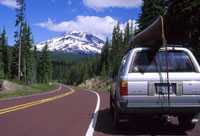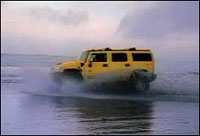You see them poised astride rocky crevasses, fording forest streams, or rising huge and solitary in the shadow of a mountain peak. No, we’re not talking about grizzly bears; we’re talking about sport utility vehicles.

Spoiling the view.
“Jawbone Chatters. Spine Shivers. Engine Roars. Everest at -11 degrees,” proclaims one ad for the Toyota 4Runner. “If you really want to put your life on the line, the new V8-powered GX is more than capable of taking you to the kinds of places where danger lurks at every corner,” promises an ad for a new Lexus SUV.
SUVs are sold on the fantasy of trailblazing, adrenaline-filled adventure, and as a sales pitch, it seems to be working: SUVs are the fastest-growing category of passenger vehicles. But reality finds these behemoths looming in front of dry cleaners and pizza parlors, clogging city streets and highways, and taking up space at suburban shopping malls. Or, as the Lexus ad copy concedes, your SUV will probably be taking you someplace “where the only risk you’re likely to face is going off your diet.”

High and Mighty
By Keith Bradsher
PublicAffairs,
468 pages, 2002
Selling the false promise of adventure is one thing — what tradition could be more time-honored among automakers? But SUVs come packaged with an implicit assurance of safety; why put your kids in a sedan when you can cushion them inside a three-ton tank? Yet as Keith Bradsher, former Detroit bureau chief for the New York Times and current head of the paper’s Hong Kong bureau, amply documents in High and Mighty, “SUVs represent the biggest menace to public safety and the environment that the auto industry has produced since the bad old days of the 1960s, before the advent of most safety and pollution control devices in cars.” Bradsher attributes the success of SUVs to, “extremely cynical design and marketing decisions by automakers” and “poorly drafted government regulations.”
Those “poorly drafted government regulations” include, most notably, classification of SUVs as light trucks. In the 1970s and ’80s, while regulators were working to improve vehicle gas mileage and safety, they didn’t bother scrutinizing light trucks, which at the time were primarily used as workhorses, rather than family or commuter vehicles. Consequently, light trucks — including SUVs — are subject to far less rigorous safety and environmental regulations than those imposed on cars. These loopholes have been very profitable for automakers. “If you could save 30 percent off the cost by not meeting the safety standards, it could make a project a whole lot more attractive,” former Jeep executive William Chapin admitted to Bradsher.
But those same loopholes are costly for public health and the environment. The proliferation of SUVs has resulted in an overall decrease in U.S. fuel efficiency and an increase in greenhouse gas emissions. SUVs are allowed to emit five times as many smog-causing nitrogen oxides as cars, and a great many SUVs emit at least 50 percent more carbon dioxide than the average car. “Switching from a mid-sized car to a large SUV for a year consumes as much energy as leaving a refrigerator door open for six years,” writes Bradsher. And according to the U.S. EPA, up to 1,000 additional people succumb to respiratory problems each year because of extra smog caused by SUVs.

Ad it up.
“Perhaps the saddest part of the SUV boom,” says Bradsher, “is that it has been so unnecessary.” For the majority of driving done in the U.S (commuting and household errands), a bulky, gas-guzzling SUV is not the ideal vehicle. As a Honda executive told Bradsher, SUVs have been deliberately designed to attract those who will buy “the image of the SUV first, and then the functionality.” (Automakers’ surveys and focus groups reveal that SUVs tend to appeal to those who are insecure, self-centered, and who care little about their neighbors or community.)
Drawing on his extensive reporting for the Times, Bradsher details the evolution of the SUV from its beginnings as a no-frills, bumpy-riding jeep favored by the landed gentry for backcountry fishing trips to its current status as a chic substitute for the station wagon. He explains how SUVs’ great weight means that they take much longer to stop than smaller vehicles (4-wheel drive helps acceleration, not braking), how their high centers of gravity makes them dangerously prone to rollovers, and how their weight and height makes them difficult to maneuver, bad for road visibility, and causes them to “inflict massive damage in collisions.” Combine this with the environmental harm caused by their gas guzzling engines, and what you get, writes Bradsher, “are the world’s most dangerous vehicles.”
If you are going to take on the most profitable and popular product of one of America’s most powerful industries, you’d better be prepared to back up your claims. Bradsher has been careful to do just that, making it impossible to dismiss High and Mighty as the work of a spoilsport or wacky environmentalist. Moreover, having thought long and hard about the complex problems posed by SUVs, Bradsher devotes a chapter to possible solutions, including raising gasoline taxes, changing the way liability rates are calculated, and restricting the use of grille guards as well as making other structural improvements to the vehicles. But the situation is extremely knotty; given the vast number of SUVs on the road and their immense popularity, environmental and safety experts will be grappling with these problems for years to come.
So if you find yourself blinded by the glare of high-mounted headlights or have your view of oncoming traffic blocked by the seven-foot roof of a Ford Excursion, and think that given all the tanks on the road, you be safer driving one too, think again. As readers of High and Mighty will learn, SUVs deserve not only our loathing, but also our fear.

